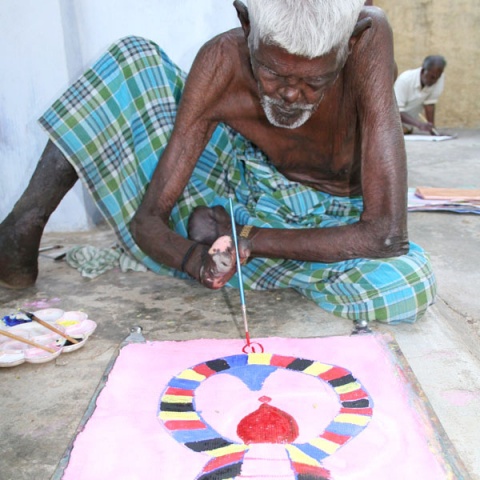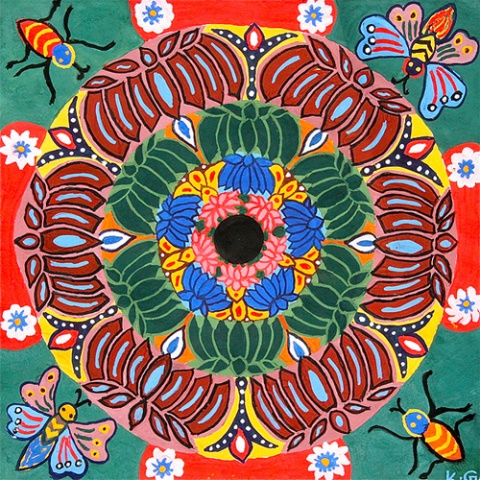Revolutionary Acts At The Community Level: The Bindu Leprosy Project
By Colin Todhunter
15 August, 2012
Countercurrents.org
 If you ever pass through Chengalpattu, 55 kms south of Chennai, you may be forgiven for thinking that it’s just another small, dusty south Indian town with its ‘meals’ restaurants, temples and concrete box buildings. If you thought that, though, you would be wrong. There is something special about this town. Close by is Bindu Art School, and it’s not just any old art school.
If you ever pass through Chengalpattu, 55 kms south of Chennai, you may be forgiven for thinking that it’s just another small, dusty south Indian town with its ‘meals’ restaurants, temples and concrete box buildings. If you thought that, though, you would be wrong. There is something special about this town. Close by is Bindu Art School, and it’s not just any old art school.
Bindu Art School was set up in 2005 in the Bharatapuram leprosy colony. It was started by Austrian artist Werner Dornik and Padma Venkataraman, an activist who first brought the concept of microlending to leprosy colonies.
There are estimated to be over 1,000 leper colonies in India, but the forced segregation of people is unnecessary in places where adequate treatments are available. Leprosy is primarily a disease of the nerves and mucosa of the upper respiratory tract. Left untreated, it can be progressive, causing permanent damage to the skin, nerves, limbs and eyes. Although leprosy is caused by a microbacterium, not by the wrath of God, in India people with leprosy are stigmatized, stuck at the bottom of a caste system that technically no longer exists. Contrary to what many may believe, the condition is not contagious after treatment and there is no need for segregation.
I initially got talking with Werner Dornik by accident in my Chennai hotel a few years ago, and he invited me to visit the art school. Werner, a multimedia artist from Bad Ischl in Austria, was 18 on his first visit to India in 1977, when he saw lepers begging on the streets. Unfortunately, you can still see that today.
After his first visit to India, he began to send donations to a leprosy home and, in 1981, contributed the proceeds of his photo exhibition in Austria to other leprosy homes in India. A chance meeting in 1995 in Vienna with Padma (daughter of former president of India, R. Venkataraman) eventually set things in motion.
On one of his visits to the Bharatapuram colony, Werner was very impressed with the traditional Indian 'kolams' that were being drawn by people whose fingers were deformed and reduced to stubs. Werner thought that using art as a therapy would be a good idea. But, as some of the elderly residents of the colony had hands that looked like claws, Werner taped paintbrushes to their fists and started them out with just two colours, black and blue. At first, the general mood of the painters resulted in art that was dark and depressing.
Werner told me, "There’s no teaching here. The aesthetics are all their own. Students start with black and white, before they move on to colours. When they finally get to use all the colours, there's an unrestrained explosion of life: forests, pink sunsets and even a hospital lined with patients that’s a kaleidoscope of colour and honesty, but no pain."
He continues, "There were no rules or any such thing as good or bad. Nor did I go into any technical details of art. The students were free to paint anything."
In March 2006, some paintings were exhibited in Chennai. One of the students, former handloom worker Armugam, who was forced to take to begging when he contracted leprosy, says, "I am so happy today. I realise I can also be creative. And at night when I sleep I dream of colours."
Things have moved on since that first exhibition. The 27 painters have subsequently had their work shown in trendy galleries from Vienna and London to Washington and Tokyo. Some of the paintings have sold for 200 euros. One of the four painters who made the trip to Vienna told an interviewer that he had received so much love and respect there that he almost forgot he had leprosy. Quite a statement for someone who had lived most of his life as an illiterate 'untouchable'.
The project aims to be self sustaining. All money from the sales of the paintings goes to the artists and the project: one-third to the art school, one-third to the artists (divided equally among all 27), and one-third to start art schools in the other leprosy colonies. Another similar school has recently been set up in Varanasi.
The results have been so impressive that it is supported by the Indian Council for Cultural Relations, the Austrian government and the Nippon Foundation in Japan. Reputed Indian artists including S.H. Raza, Aparna Caur are also involved.
On visiting the school, it was clear that the artists are their own teachers, learning from one another and themselves. Over time, the art has acted as both a medium for self expression and as a social catalyst. As the artists began to change, their art has become more whimsical, more joyous, and, instead of not even talking to each other, they now laugh and play games. They've also stopped asking for so many pain pills.
The art school really has had a deep impact on people who for too long have been socially excluded and placed at the very bottom of the heap in India.

The ethos of Bindu Art School is that of communal living, self help, fellowship, dignity and independence. There is a definite whiff of the Gandhian tradition in the air, and much of Werner Dornik’s personal outlook and his own art projects seek to make people aware that capitalism, crass materialism and consumerism are a deadening and ultimately self-destructive burden for humanity.
The Bindu Art project has revolutionized the lives of a few of the world’s most disadvantaged people. And that does not surprise me because Werner says his politics is ‘love’. That’s not a bad starting point as revolutionary acts take many forms, and the most effective ones often stem from a feeling of empathy not anger and camaraderie not hate.
The world is facing many problems and while resisting imperialism, militarism and exposing the lies of neo-liberalism are much needed and credible acts, social change is often incremental and revolutionary acts can often be small scale and at the community level. Such acts, instigated by ordinary folk, can impact people’s lives directly. Whether it’s the anti-capitalist/banker Occupy Movement, the Navdanya movement in India that seeks to support traditional agriculture or Bindu Art School, all have the same goal – to ensure that people secure dignity and independence and freedom from exploitation.
Bindu Art website: http://www.bindu-art.at/
Colin Todhunter : Originally from the northwest of England, Colin Todhunter has spent many years in India. He has written extensively for the Deccan Herald (the Bangalore-based broadsheet), New Indian Express and Morning Star (Britain). His articles have also appeared in various other newspapers, journals and books. His East by Northwest website is at: http://colintodhunter.blogspot.com
Comments are moderated


